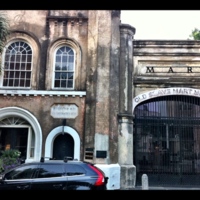
Old Slave Mart Museum
The first African-American Museum, the Old Slave Mart Museum has been open sporadically since 1938. Located in Charleston, South Carolina, it was built in 1859. It is thought to have been the last surviving slave auction gallery in South Carolina. It was used briefly before the American Civil War ended slavery in the American South.
The building itself is living history, and inside there are displays attesting to what happened there, as well as providing wider context about American slavery and its lasting legacies. The collections are quite sparse in terms of objects from the slave trade but there are many photographs.
The museum makes use of personal testimonies to bring the history to life through the voices of the enslaved and their descendants. These are presented as audio clips, available for visitors to sit and listen to. The interpretation features many examples of statistics, as well as maps and contemporary images.
All of the above forward the museum's mission to broaden public understanding of Charleston as a slave-trading centre in order to reach out to the local community.
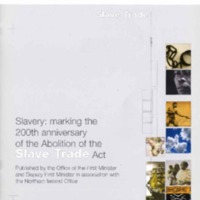
Slavery: marking the 200th anniversary of the Abolition of the Slave Trade Act
The official publication from the Office of the First Minister and Deputy First Minister in association with the Northern Ireland Office, based on the research of historian Nini Rodgers.
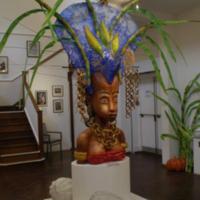
Parallel Views: Black History in Richmond
The Parallel Views exhibition and its associated community engagement programme explored the relevance of the bicentenary for communities in the London Borough of Richmond upon Thames, uncovering local associations with slavery and its abolition. It also told the parallel story of twin town Richmond, Virginia, USA, to broaden understanding of the transatlantic slave trade and the impact of its demise. The exhibition examined evidence of individuals of African origin who had come to Richmond, and residents with financial links to slavery and the slave trade, and to abolitionism. A film piece by choreographer and dance historian Dr Rodreguez King-Dorset explored the use of dance within the free Black community in London during the era of abolition. A display of contemporary artwork responded to the ideas of the exhibition. A sculpture by carnival artist Carl Gabriel linked consumers in Richmond and the conditions of production of slave-grown crops. The design was inspired by a series of workshops with local families. Artist-led workshops for children and young people led to the creation of a carnival costume piece which was included in the exhibition.
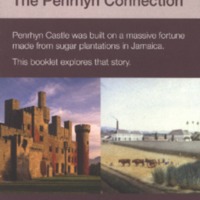
Sugar and Slavery - The Penrhyn Connection
Penrhyn Castle on the outskirts of Bangor in Wales is owned by the National Trust. In 2007, the bicentenary was marked with a special exhibition and accompanying events exploring the connections between the Castle and the fortune of its former owners, the Pennant family, built on Jamaican sugar from one of the largest estates on the island. The exhibition featured the story of Richard Pennant, 1st Lord Penrhyn, a wealthy merchant and MP for Liverpool who fought against abolition in Parliament. Some of the research was carried out by members of the local community, who were trained in archival research by exploring the Penrhyn Jamaica papers held at Bangor University, which included Richard Pennant's letters as absentee landowner.
The project created links between a local school near the Castle, Banks Road school in Liverpool and Mavisville school in Kingston, Jamaica. All three schools provided art, prose and poetry to the exhibition. Workshops were held for all visiting schools. Accompanying events included art days where a local artist worked with visitors to explore the meaning of landscape painting in the context of slavery; a Caribbean weekend; and a day of activities and workshops with a multi-faith groups of teenagers from Liverpool. A DVD of all the information gathered was given free to schools and libraries.
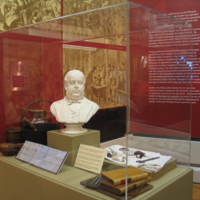
Revealing Histories: Remembering Slavery (Touchstones Rochdale)
Touchstones Rochdale was one of eight heritage bodies in the ‘Revealing Histories: Remembering Slavery’ partnership in Greater Manchester. The project set out to explore the history, impact and legacy of slavery on Britain through collections and community links in the North West.
Rochdale's connections to slavery were explored though two exhibitions at Touchstones Rochdale, which featured museum trails and family events. 'The Fight to End Slavery: A Local Story' examined the town's role in the struggle to end slavery in North America, including the work of prominent abolitionists from Lancashire. The exhibition also looked at the impact of the Lancashire cotton famine, which occurred as a result of the blockade of southern American ports during the Civil War. 'Linking Threads: Textile Industrialists and the Art Collection' focused on works given to the Rochdale Art Gallery collection by benefactors who had links to the local textile industry, such as Robert Taylor Heape and Richard Heape.
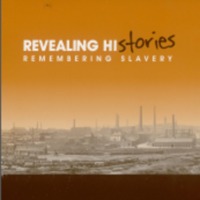
Revealing Histories: Remembering Slavery (Gallery Oldham)
Gallery Oldham was one of eight heritage bodies in the ‘Revealing Histories: Remembering Slavery’ partnership in Greater Manchester. The project set out to explore the history, impact and legacy of slavery on Britain through collections and community links in the North West.
A number of objects from Gallery Oldham's collections were identified as having links to the histories of the slave trade and slavery, focused on the themes of sugar, abolition, the American Civil War and the cotton industry. Two exhibitions also played a role in this trail. 'Cops and Bobbins', exploring Oldham's textile industry, illuminated the links with American slavery in the 19th century. 'Oldham Votes' looked at the significance of the election of 1832, during which slavery and abolition were debated. In collaboration with Touchstones Rochdale, Gallery Oldham also hosted a special day event, 'Slavery - what's it got to do with us?', featuring family activities, debate, and performances of African dance.